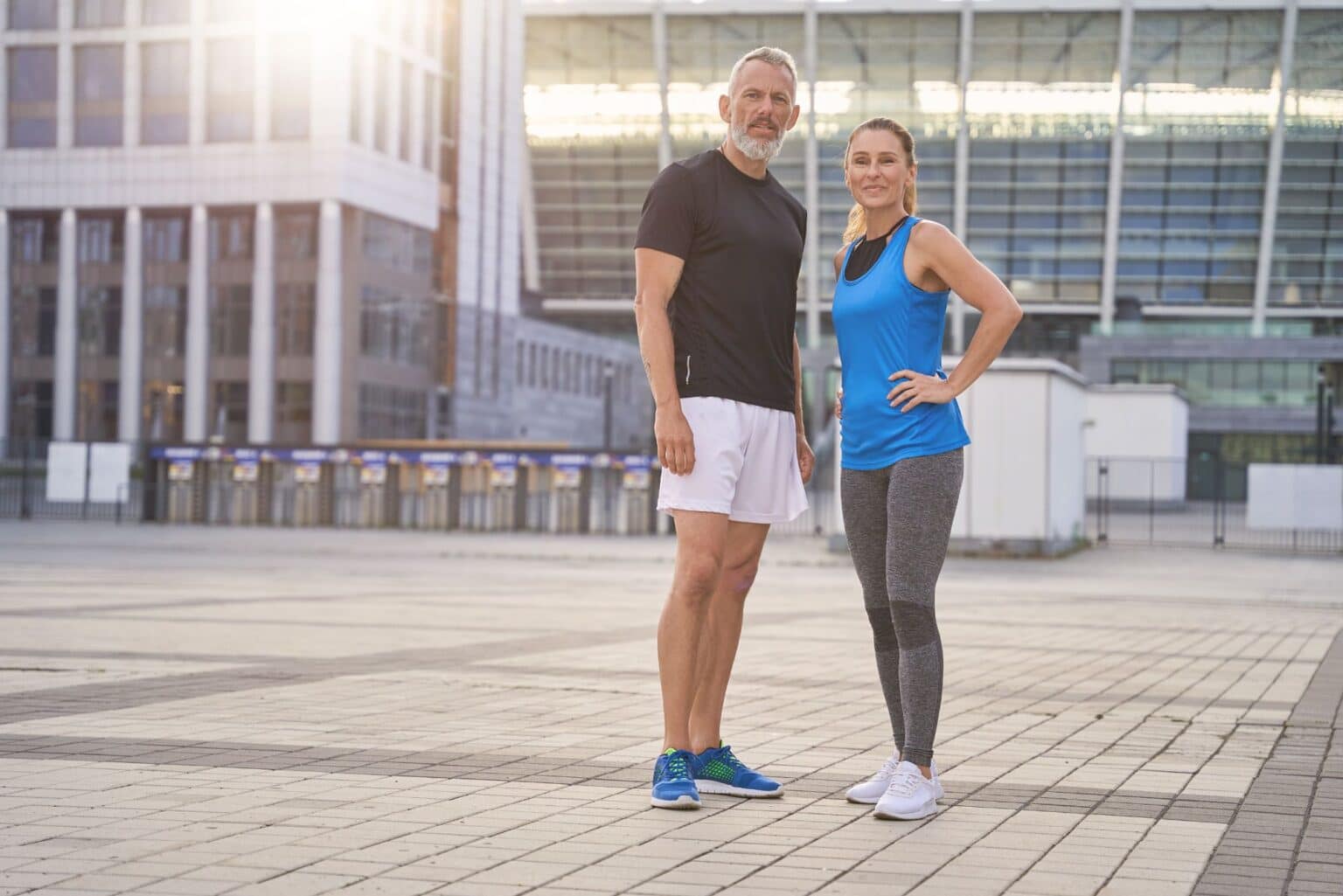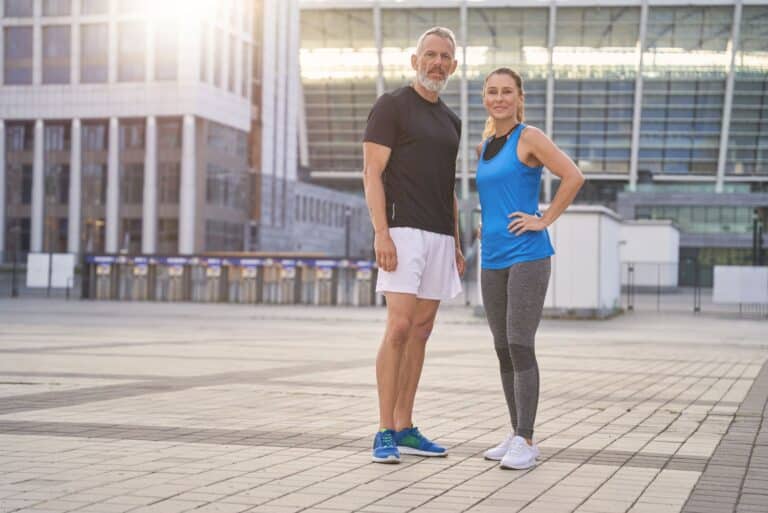


Can you start running at 50?
Absolutely, and safely too. In this guide, we’ll explain how to begin, stay safe, and enjoy the benefits of running at this stage in life. Expect tips on safety, gear, building your routine, and staying motivated.
The first and most pressing question for many older athletes is whether it is safe to start running at 50. The answer is a resounding yes, provided you take the appropriate precautions. Safety should always be the top priority, and the best way to ensure this is by undergoing a medical examination. A doctor can identify any potential health concerns and give you the green light to start running.
A medical examination can identify any potential risk factors. Once you get the green light, start slowly and pay attention to how your body responds. Beginning with a gradual pace allows your body to adapt without risking injury. Remember, older adults face a higher risk of injury when starting a running routine, so adapting your training to suit your body’s evolving needs as an older runner is essential.
A good pair of running shoes is essential to prevent injuries and improve comfort during runs. The right pair of quality footwear allows you to start a run/walk programme, which combines walking and running intervals to ease your body into the routine. This approach reduces stress on the body and helps prevent injuries.
Lastly, adapt your training to your body’s changing needs, incorporating rest days and staying mindful of how your body feels. Starting a running routine at 50 is not about competing with younger runners; it’s about embracing your journey and making adjustments as needed to stay healthy and injury-free.
Running in your 50s brings a wealth of benefits, both physically and mentally. It is not just about staying fit; it’s about enhancing your overall quality of life. Regular running:
In addition to physical benefits, running positively impacts mental health by alleviating anxiety and depression, fostering a more positive outlook. Joining a running club or having a running buddy can also enhance mental well-being by providing social support and accountability.
Running enhances self-esteem and gives a sense of accomplishment, making you feel strong and healthy as you age during your golden years.
Regular physical activity, such as running, offers numerous health benefits, particularly as you age. It significantly improves cardiovascular health, enhances muscle strength, and supports bone density, key factors for maintaining fitness and preventing fractures in older adults.
Running also promotes joint health. With proper footwear and form, the impact on joints can be minimised, helping to preserve joint mobility and reduce the risk of arthritis and other joint-related issues over time.
Beyond these benefits, running improves balance and coordination, lowering the likelihood of falls and injuries often associated with ageing. It boosts overall fitness, strengthens muscles, and keeps the body agile and resilient.
Incorporating running into your routine can lead to long-lasting health advantages, ensuring you stay active, strong, and energised for years to come.
Running is a powerful mental health tool, alleviating anxiety and depression and helping maintain a positive mindset. The act of running itself, combined with the endorphins released during physical activity, helps enhance your mood and reduce stress levels.
Joining a running programme or group offers social support, crucial for mental health. Having a network of fellow runners can keep you motivated and accountable, encouraging you to stick to your routine. This sense of community fosters a positive mindset, helping you stay healthy mentally and emotionally.
Ensuring you have the right gear is essential. A good pair of running shoes prevents injuries and enhances comfort during runs. Older runners should opt for running shoes that offer excellent arch support, a proper fit, a stride that suits their gait, and ample cushioning. These key features are essential for preventing injuries and ensuring lasting comfort during every run.
Replace running shoes every 300-500 miles to maintain optimal support and cushioning. Breathable shoes with mesh vents help reduce blisters by allowing moisture to escape, especially in wet conditions. Investing in the right shoes can make all the difference in your running experience.
Soft, sweat-wicking running clothes and socks keep you comfortable and dry, regulate body temperature, and prevent chafing. Comfortable clothing can enhance your overall running experience, making it more enjoyable and sustainable.
Accessories like a running watch, hat or visor, and hydration belt can enhance your running experience and help you stay motivated. These items can enhance your running routine and help you stay motivated and focused on your goals.
Joining a running club or finding a buddy can provide support and motivation, making the experience more enjoyable and keeping you committed. Whether you are training for a half-marathon or just running for fun, having the right gear and support can make all the difference.

Establishing a running routine is key to consistency and progress. Start slow by gradually letting your body adapt without risking injury. Many coaches suggest beginning with walking before gradually incorporating run/walk intervals. This method minimises stress on the body, lowers the risk of injury, and provides a safe, effective foundation for starting a running routine.
Engaging in a structured running programme can enhance endurance and improve your overall physical activity. By the end of week 10, aim to walk for 5 minutes, run for 20-25 minutes, and then walk for another 5 minutes. This gradual approach ensures that you build your running routine safely and effectively.
If you are new to running and looking for a structured programme to help you get started, here at Coach the Run we offer a free Beginner 5K Training Plan to get you started. This 5k training plan is designed by our head coach, Mike Gratton, winner of the 1983 London Marathon. This 8-week training plan is tailored to guide you through your first 5k road race.
Our plan is completely free – download it now!
This plan provides a gradual progression in mileage and intensity, allowing you to build your endurance and improve your overall running performance.
Warming up and cooling down are essential. Older runners should incorporate gradual warm-ups to boost circulation and prep their muscles. Longer warm-up times effectively prepare your body for running. Dynamic stretches like hip circles, donkey kicks, and leg swings improve flexibility and reduce injury risk.
Warming up boosts blood flow, improves joint movement, and reduces injury risk. Include dynamic stretches to prepare muscles and enhance flexibility. Stretching is vital for older runners as it aids soft tissue recovery and enhances flexibility.
Cooling down is equally important, helping normalise your heart rate and preventing muscle stiffness. Gentle stretches and light walking help gradually reduce your heart rate and promote recovery. A proper cool-down prevents injuries and ensures faster recovery.
Combining walking and running intervals helps beginners ease into a running routine safely. The Galloway interval method, which involves walk/run intervals, can help older runners manage their routine safely and build endurance without excessive strain. A recommended starting workout involves a 20-minute session consisting of a 5-10 minute warm-up and intervals of 30 seconds running followed by 2 minutes of walking.
Walk/run intervals build endurance and allow gradual body adaptation. In the initial phase of your runs, ensure everything works and ease into the run. This approach helps prevent injuries and makes the running experience more enjoyable.
To improve your running endurance, follow these guidelines:
This gradual progression ensures that your body adapts safely and effectively to the increased running intensity.
For runners over 50, following guidelines is essential to stay healthy and avoid injuries. Start by running every other day or following a schedule of two to three consecutive running days, allowing sufficient time for recovery. Adopt a hard/easy/easy cycle, alternating high-intensity sessions with lighter efforts to give your body ample time to recuperate.
Rest days are just as important as training. They allow your body to adapt to the stress of previous runs and help prevent injuries. Aim for 1-2 high-intensity workouts per week, using your easy days to recover and maintain the quality of your harder efforts.
To avoid overtraining or injury, increase your running intensity gradually, following the 10% rule: do not increase mileage or intensity by more than 10% per week. With a balanced approach, you can continue running strong and safely for years to come.
Including cross-training activities like cycling or swimming on rest days can be beneficial. Low-impact activities are effective rest day options that maintain fitness without stressing joints. Cross-training enhances running performance and overall physical health.
More recovery time between runs prevents injury and improves performance. Listen to your body and adjust your training plan accordingly to stay healthy and injury-free.
Proper running form is crucial for efficiency and injury prevention. Starting a running programme should focus on proper form to avoid joint stress. A straight posture reduces back strain and improves breathing. Engaging core muscles stabilises the body and enhances running efficiency.
A proper arm swing maintains balance and rhythm. Move your arms in a relaxed, forward-and-backwards motion, close to your body. This maintains your form and reduces unnecessary energy use.
Synchronised breathing rhythm enhances running efficiency. Focus on deep, rhythmic breathing for adequate oxygen supply to muscles. This can improve your endurance and make running more comfortable.
A mid-foot strike minimises impact forces on joints. This reduces the risk of injuries and ensures a smoother running experience. Notice your one foot landing and adjust to improve form.
Proper shoes and form make running more enjoyable and injury-free. Focus on improving your form gradually and stay consistent with your training routine.
Strength training maintains muscle mass, improves stability, and reduces injury risk for older runners. Strength training for 20-30 minutes, 2-3 times a week, enhances running performance and overall health.
Cross-training activities like cycling, swimming, and yoga are excellent ways to boost overall fitness while offering a productive alternative for rest days. These low-impact exercises reduce joint strain and complement your running routine, helping you stay active and balanced.
Bodyweight exercises are crucial for developing foundational strength, especially for older runners. Incorporating the following movements into your routine can help improve stability, endurance, and overall performance: planks, push-ups, lunges, hinges, carries, pushes, pulls, and squats. These exercises build muscle mass, improve joint health, and support effective running by strengthening connective tissues.
Strength exercises can significantly enhance running performance and prevent injuries. Diverse movements like carries, pulls, and resistance bands enhance muscle strength and stability.
Add these exercises to your routine for improved fitness and a successful running journey.

Setting realistic goals is essential for older runners, as our bodies may need more time to build fitness than younger runners. Goals should match your age and fitness level. Focus on small, consistent improvements rather than past achievements.
Incremental progress, like gradually increasing running time or distance, is key. Start with:
Varying running surfaces and adding uphill components can enhance recovery and reduce injury risk. This keeps training interesting, challenging, and maintains motivation.
Setting realistic, achievable goals helps maintain motivation and track progress effectively. Celebrate all achievements, no matter how small, and keep pushing toward your next milestone.
Staying motivated is vital for a consistent running routine. Joining a running group offers support and motivation for older runners in this age group. Training with a friend or group increases enjoyment and accountability.
Creating clear, smaller milestones from larger goals can help maintain focus and motivation. Celebrate even minor achievements to enhance your motivation and sense of progress. Listening to music or podcasts during runs can provide entertainment and boost motivation.
Reminding yourself of your initial reasons for starting can keep your motivation alive. Whether it’s for health, fitness, or personal achievement, keeping your goals in mind can help you stay focused and committed.
By incorporating these strategies, you can stay motivated and enjoy your running journey. Surround yourself with supportive people, set achievable goals, and celebrate your progress along the way.
Listening to your body is crucial for preventing unnecessary fatigue and ensuring longevity in your running journey. Ignoring pain can exacerbate injuries, making it important to rest when experiencing discomfort. If you feel the onset of an injury while running, be proactive and don’t ignore warning signs.
If you’re not feeling fully recovered, listen to your body and avoid forcing a run. Recovery times vary significantly depending on individual circumstances, and older runners should be flexible with their goals. Focus on the parts of your body that feel good while running if some parts are complaining.
Patience, consistency, and listening to your body are key elements for a successful running journey in your 50s. If you feel tired during or after runs, consider less intensity or additional rest days. By paying attention to your body’s signals, you can prevent injuries and maintain a healthy running routine.
Recovery is particularly important for older runners to prevent injuries and maintain performance over time. Key aspects include:
Hydration is vital, as older athletes may experience reduced thirst and are at a higher risk of dehydration. Maintaining adequate hydration prevents joint problems associated with dehydration. Water and hydration drinks with electrolytes should be used to stay hydrated.
Post-exercise nutrition should include a good mix of protein and carbohydrates to aid muscle repair. Using recovery tools like foam rollers and compression garments can help alleviate muscle soreness and promote muscle health. Regular massages, foam rolling, and added rest days are proactive steps for preventing injury while running at 50.
Active recovery through low-stress activities can be more beneficial than complete rest for older runners. Enhancing your recovery strategies ensures you can run effectively for a longer time and stay injury-free.
Remember, age is just a number! With the proper training, recovery strategies, and self-care techniques, older runners can continue enjoying their favourite activity for years to come.
Starting a running routine at 50 is a rewarding journey that brings numerous physical and mental benefits. From ensuring it’s safe, selecting the right gear, and building a running routine, to mastering proper form, incorporating strength training, setting realistic goals, and staying motivated, every step is crucial for a successful running experience.
By listening to your body, prioritising recovery, and staying consistent, you can enjoy the numerous benefits of running well into your golden years.
So what are you waiting for? Download our free Coach the Run 5k Beginner Training Plan and get started today!
Embrace the journey, celebrate your achievements, and keep pushing towards your next milestone. Happy running!
Absolutely, it’s safe to start running at 50! Just remember to consult your doctor and ease into it, and you’ll be on track to enjoy the many benefits of running in no time.
Running in your 50s significantly boosts your cardiovascular health, muscle strength, and mental well-being, while also lowering the risk of falls and injuries. Embrace this wonderful opportunity to enhance your overall health and vitality!
To stay comfortable and perform your best as an older runner, make sure you invest in a good pair of running shoes, moisture-wicking clothing, and useful accessories like a running watch and hydration belt. Equip yourself well, and you’ll enjoy your runs even more!
To successfully build your running routine, start slow by incorporating walking before moving to run/walk intervals. Follow a structured program while ensuring you warm up and cool down properly, and you’ll set yourself up for success!
To stay motivated in your running journey, consider joining a running group and setting achievable goals, while celebrating even the smallest achievements. Keeping the experience enjoyable by listening to music or podcasts can also help you stay engaged and inspired!
In this guide, we’ll explain how to begin, stay safe, and enjoy the benefits of running at this stage in life.
Share this article
Feeling sluggish and lacking motivation for running? You’re not alone. It can be tough to...
How much attention should I pay to Heart Rate Zones? I use Strava Pro, it...
Running is one of the simplest and most efficient exercises beginner runners can do. It...
Running is a popular form of exercise that can help you lose weight and improve...
I’ve missed a week of the plan from illness, what should I do? My race...
Warm-up exercises are essential to prepare your body for a run. These exercises help increase...
We’re here to make sure you’re up-to-date with the latest running tips, events and product discounts – we’ve always got your back! Rest assured, we value your privacy and would never dream of selling your address.
BONUS: Sign up today and receive a FREE code for our Sub-4-Hour Marathon Plan